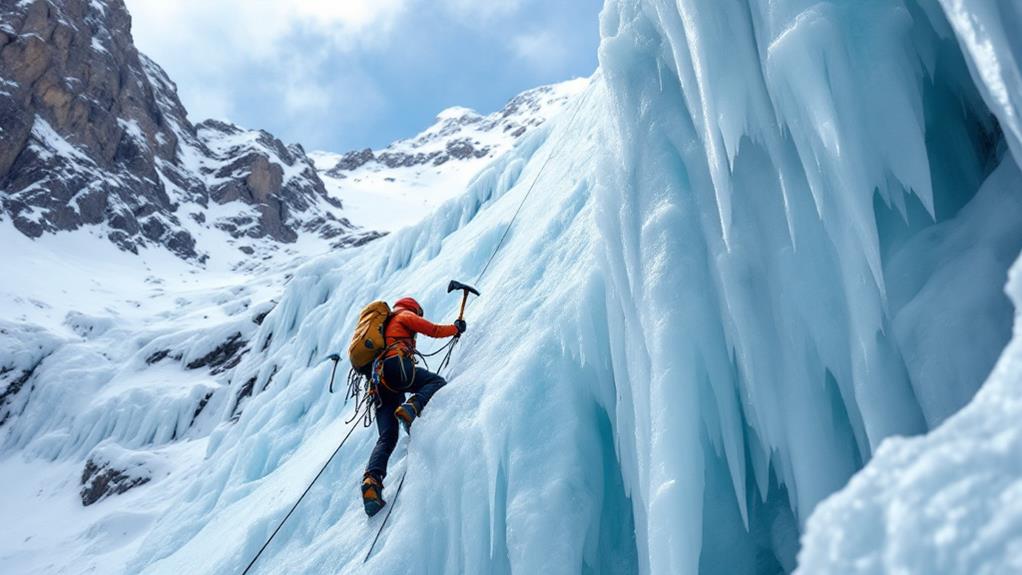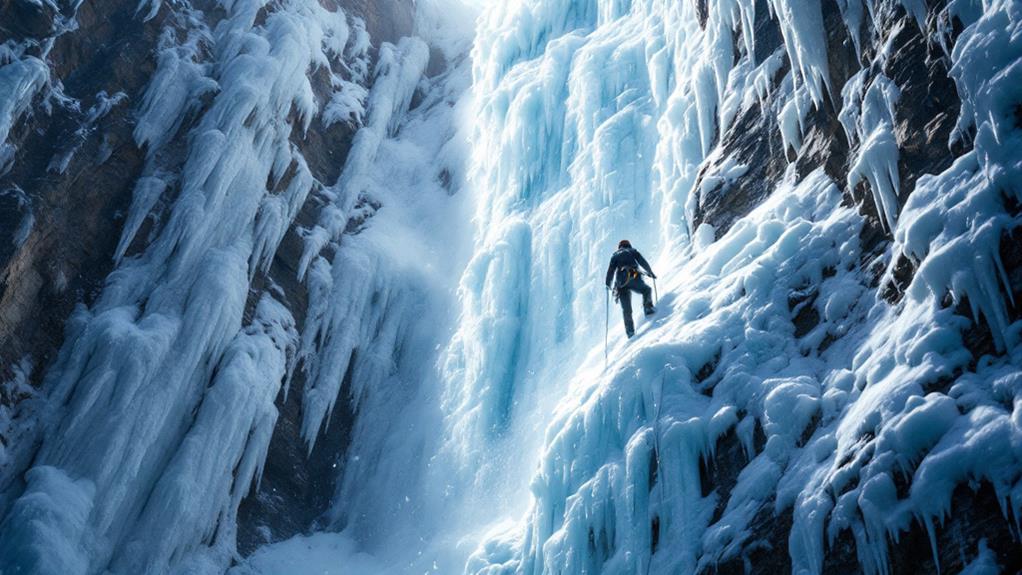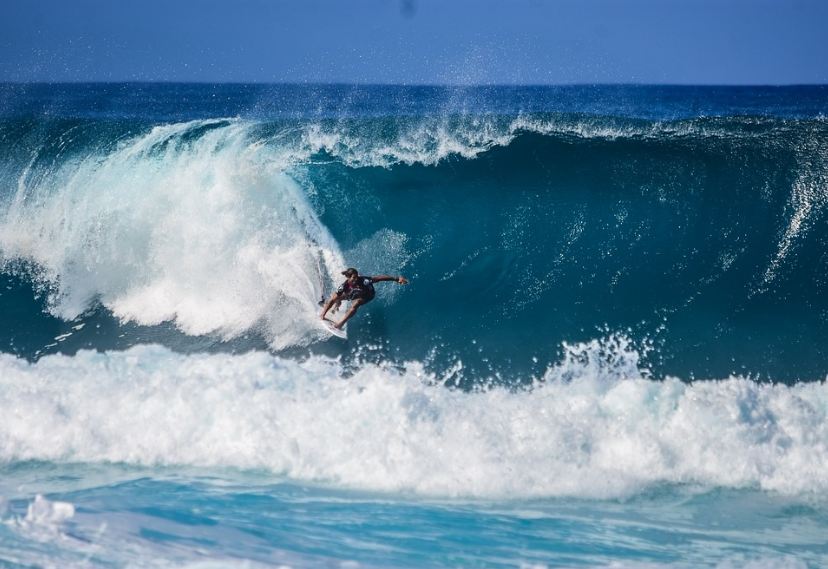Why Is Ice Climbing an Extreme Sport?

Ice climbing is an extreme sport due to its intense environmental challenges and physical demands. You'll face biting cold, howling winds, and unstable ice surfaces while wielding specialized equipment like ice axes and crampons. The sport requires exceptional strength, endurance, and mental fortitude as you navigate treacherous terrain and make split-second decisions. Unpredictable ice conditions and the constant risk of injury or avalanches add to the sport's extreme nature. Ice climbing demands unwavering focus, advanced technical skills, and the ability to manage high-risk situations. For thrill-seekers, the intense clarity and sense of accomplishment make it an addictive pursuit. Discover why ice climbers keep pushing their limits in this exhilarating sport.
Extreme Environmental Challenges
In the face of nature's harshest conditions, ice climbing presents extreme environmental challenges that push climbers to their limits. You'll confront biting cold temperatures that can plummet well below freezing, often accompanied by howling winds that chill you to the bone. These conditions aren't just uncomfortable; they're potentially life-threatening, increasing your risk of hypothermia and frostbite. The popularity of ice climbing has grown due to the challenge and scenic natural settings, but the demands are extreme.
As you scale icy formations, you're constantly battling unstable surfaces. The ice you're climbing can be unpredictable, varying in thickness and stability. It may crack, shatter, or even melt under your weight or the warmth of the sun. You'll need to quickly assess and adapt to changing conditions as you climb. Proper training, experience, and risk assessment are necessary to manage the risks in ice climbing.
Weather can turn on a dime in mountainous regions, leaving you exposed to sudden storms, whiteouts, or avalanches. Visibility can drop rapidly, making navigation treacherous. You'll also face the challenge of limited daylight hours in many ice climbing locations, adding time pressure to your ascent and descent.
These extreme environmental factors demand exceptional physical endurance, mental fortitude, and specialized skills, truly earning ice climbing its status as an extreme sport.
Specialized Equipment and Techniques
Ice climbing demands a specialized arsenal of equipment and techniques that set it apart from traditional rock climbing. You'll need ice axes, crampons, and ice screws to ascend frozen surfaces. These tools require precise handling and placement to ensure your safety and progress.
Your ice axes become extensions of your arms, allowing you to hook onto ice features and create secure anchor points. Crampons, sharp metal spikes attached to your boots, provide crucial traction on slippery surfaces. You'll learn to kick these into the ice with just the right force to maintain stability without shattering the frozen surface.
Ice screws serve as your primary protection, drilled into the ice to create anchor points for your ropes. You'll master the art of efficiently placing these screws while maintaining your balance on vertical ice faces.
Techniques like front-pointing (using only the front spikes of your crampons) and tool matching (placing both ice axes at the same level) are essential for efficient climbing. You'll also develop a keen eye for reading ice formations, identifying weaknesses, and choosing the safest route up the frozen wall.
Physical Demands and Endurance

Beyond mastering technical skills, ice climbing poses extraordinary physical challenges. You'll need exceptional upper body strength to wield ice axes and pull yourself up vertical ice formations. Your legs and core will be constantly engaged as you kick into the ice and maintain balance. The sport demands a unique combination of power and endurance, as climbs can last for hours in harsh conditions.
You'll face extreme cold, which saps your energy and affects your body's performance. Your cardiovascular system will be pushed to its limits as you ascend at high altitudes with thin air. The mental strain of maintaining focus and overcoming fear adds to the physical toll.
Flexibility and agility are crucial as you navigate unpredictable ice formations and search for stable placements. You'll need to develop specialized muscle memory for efficient movement on ice. Recovery between climbs is essential, as the sport can be incredibly taxing on your joints and tendons.
To excel in ice climbing, you'll need to commit to a rigorous training regimen that includes strength training, cardio, and sport-specific exercises. This level of physical preparation sets ice climbing apart as a true extreme sport.
Mental Fortitude and Risk Management
Courage forms the bedrock of ice climbing's mental challenges. You'll need unwavering focus and composure to tackle vertical ice formations while battling extreme cold and unpredictable conditions. As you ascend, you must constantly assess the ice's stability, making split-second decisions that can mean the difference between success and peril.
Risk management is paramount in ice climbing. You'll learn to evaluate weather patterns, ice quality, and potential hazards like falling ice or avalanches. Developing a keen eye for route selection and anchor placement becomes crucial for your safety. You'll also need to master the art of self-rescue and partner rescue techniques, preparing for worst-case scenarios.
Mental resilience plays a key role in overcoming fear and doubt. You'll face moments of intense anxiety as you navigate challenging sections or encounter unexpected obstacles. Developing strategies to stay calm under pressure and maintain focus despite physical fatigue becomes essential. You'll also need to cultivate patience and adaptability, as conditions can change rapidly, forcing you to adjust your plans on the fly. Ultimately, ice climbing demands a unique blend of mental toughness and calculated risk-taking that sets it apart as an extreme sport.
Unpredictable Ice Conditions

The ever-changing nature of ice formations adds another layer of complexity to this extreme sport. You'll face constantly shifting conditions that require adaptability and quick thinking. Ice can transform rapidly due to temperature fluctuations, sunlight exposure, and water flow beneath the surface.
You must assess the ice quality before and during your climb. Factors like thickness, consistency, and structural integrity can vary greatly, even within the same route. Here's a breakdown of common ice types you'll encounter:
| Ice Type | Characteristics | Climbing Difficulty |
|---|---|---|
| Pillar | Vertical column | High, requires precision |
| Curtain | Thin, sheet-like | Moderate, fragile |
| Chandelier | Hanging icicles | Extreme, unstable |
As you climb, you'll need to be vigilant for signs of weakening ice, such as hollow sounds, cracks, or discoloration. These indicators can signal potential hazards and require immediate action. You'll also contend with falling ice, which can be dislodged by your movements or natural processes. This unpredictability demands constant awareness and the ability to make split-second decisions to ensure your safety and success in this challenging environment.
Adrenaline Rush and Thrill Seeking
For many ice climbers, the intense adrenaline rush is a primary draw to this extreme sport. As you ascend vertical ice formations, your body releases a surge of adrenaline, heightening your senses and sharpening your focus. This natural high can be addictive, pushing you to seek out more challenging climbs and push your limits. Ice climbing also offers a high level of risk and physical exertion, which is a key characteristic of extreme sports according to the definition in the provided knowledge. The thrill of conquering seemingly impossible frozen structures taps into your adventurous spirit. You'll find yourself constantly chasing that next big climb, eager to test your skills against nature's icy obstacles. The combination of physical exertion, mental concentration, and the ever-present element of danger creates a unique cocktail of excitement that's hard to replicate in other activities.
Ice climbing also offers moments of intense clarity and presence. As you navigate treacherous terrain, you're fully immersed in the present moment, acutely aware of every move and decision. This heightened state of consciousness can be deeply rewarding, providing a sense of accomplishment and self-discovery that keeps you coming back for more. The satisfaction of conquering challenging natural settings is unparalleled, fueling your passion for this extreme sport.




